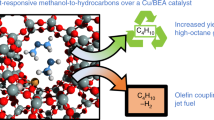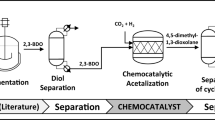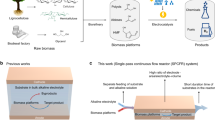Abstract
Nearly one hundred years ago, the fermentative production of acetone by Clostridium acetobutylicum provided a crucial alternative source of this solvent for manufacture of the explosive cordite. Today there is a resurgence of interest in solventogenic Clostridium species to produce n-butanol and ethanol for use as renewable alternative transportation fuels1,2,3. Acetone, a product of acetone–n-butanol–ethanol (ABE) fermentation, harbours a nucleophilic α-carbon, which is amenable to C–C bond formation with the electrophilic alcohols produced in ABE fermentation. This functionality can be used to form higher-molecular-mass hydrocarbons similar to those found in current jet and diesel fuels. Here we describe the integration of biological and chemocatalytic routes to convert ABE fermentation products efficiently into ketones by a palladium-catalysed alkylation. Tuning of the reaction conditions permits the production of either petrol or jet and diesel precursors. Glyceryl tributyrate was used for the in situ selective extraction of both acetone and alcohols to enable the simple integration of ABE fermentation and chemical catalysis, while reducing the energy demand of the overall process. This process provides a means to selectively produce petrol, jet and diesel blend stocks from lignocellulosic and cane sugars at yields near their theoretical maxima.
This is a preview of subscription content, access via your institution
Access options
Subscribe to this journal
Receive 51 print issues and online access
$199.00 per year
only $3.90 per issue
Buy this article
- Purchase on Springer Link
- Instant access to full article PDF
Prices may be subject to local taxes which are calculated during checkout




Similar content being viewed by others

References
Alsaker, K. V., Paredes, C. & Papoutsakis, E. T. Metabolite stress and tolerance in the production of biofuels and chemicals: gene-expression-based systems analysis of butanol, butyrate, and acetate stresses in the anaerobe Clostridium acetobutylicum. Biotechnol. Bioeng. 105, 1131–1147 (2010)
Tracy, B. P., Jones, S. W., Fast, A. G., Indurthi, D. C. & Papoutsakis, E. T. Clostridia: the importance of their exceptional substrate and metabolite diversity for biofuel and biorefinery applications. Curr. Opin. Biotechnol. 23, 364–381 (2012)
Green, E. M. Fermentative production of butanol—the industrial perspective. Curr. Opin. Biotechnol. 22, 337–343 (2011)
Steen, E. J. et al. Microbial production of fatty-acid-derived fuels and chemicals from plant biomass. Nature 463, 559–562 (2010)
Wang, C. et al. Metabolic engineering of Escherichia coli for α-farnesene production. Metab. Eng. 13, 648–655 (2011)
Peralta-Yahya, P. P. et al. Identification and microbial production of a terpene-based advanced biofuel. Nature Commun. 2, 483 (2011)
Blommel, P. G., Keenan, G. R., Rozmiarek, R. T. & Cortright, R. D. Catalytic conversion of sugar into conventional gasoline, diesel, jet fuel, and other hydrocarbons. Int. Sugar J. 110, 672–679 (2008)
Corma, A., de la Torre, O., Renz, M. & Villandier, N. Production of high-quality diesel from biomass waste products. Angew. Chem. Int. Ed. 50, 2375–2378 (2011)
Huber, G. W., Chheda, J. N., Barrett, C. J. & Dumesic, J. A. Production of liquid alkanes by aqueous-phase processing of biomass-derived carbohydrates. Science 308, 1446–1450 (2005)
Ren, C. et al. Identification and inactivation of pleiotropic regulator CcpA to eliminate glucose repression of xylose utilization in Clostridium acetobutylicum. Metab. Eng. 12, 446–454 (2010)
Guillena, G., Ramón, D. J. & Yus, M. Alcohols as electrophiles in C–C bond-forming reactions: the hydrogen autotransfer process. Angew. Chem. Int. Ed. 46, 2358–2364 (2007)
Hamid, M. H. S. A., Slatford, P. & Williams, J. M. J. Borrowing hydrogen in the cctivation of alcohols. Adv. Synth. Catal. 349, 1555–1575 (2007)
Carlini, C., Macinai, A., Raspolli Galletti, A. M. & Sbrana, G. Selective synthesis of 2-ethyl-1-hexanol from n-butanol through the Guerbet reaction by using bifunctional catalysts based on copper or palladium precursors and sodium butoxide. J. Mol. Catal. Chem. 212, 65–70 (2004)
Salvapati, G. S., Ramanamurty, K. V. & Janardanarao, M. Selective catalytic self-condensation of acetone. J. Mol. Catal. 54, 9–30 (1989)
Kwon, M. S. et al. Recyclable palladium catalyst for highly selective α alkylation of ketones with alcohols. Angew. Chem. Int. Ed. 44, 6913–6915 (2005)
Guillena, G., Ramón, J. D. & Yus, M. Hydrogen autotransfer in the N-alkylation of amines and related compounds using alcohols and amines as electrophiles. Chem. Rev. 110, 1611–1641 (2010)
Dobereiner, G. E. & Crabtree, R. H. Dehydrogenation as a substrate-activating strategy in homogeneous transition-metal catalysis. Chem. Rev. 110, 681–703 (2010)
Wayman, M. & Parekh, R. Production of acetone-butanol by extractive fermentation using dibutylphthalate as extractant. J. Ferment. Technol. 65, 295–300 (1987)
Roffler, S. R., Blanch, H. W. & Wilke, C. R. In-situ recovery of butanol during fermentation. Part 2: fed-batch extractive fermentation. Bioprocess Engng 2, 181–190 (1987)
Roffler, S. R., Blanch, H. W. & Wilke, C. R. In-situ recovery of butanol during fermentation. Part 1: batch extractive fermentation. Bioprocess Engng 2, 1–12 (1987)
Roffler, S. R., Blanch, H. W. & Wilke, C. R. In situ extractive fermentation of acetone and butanol. Biotechnol. Bioeng. 31, 135–143 (1988)
Jeon, Y. J. & Lee, Y. Y. Membrane-assisted extractive butanol fermentation. Ann. NY Acad. Sci. 506, 536–542 (1987)
Vane, L. M. Separation technologies for the recovery and dehydration of alcohols from fermentation broths. Biofuels Bioprod. Biorefining 2, 553–588 (2008)
Kraemer, K., Harwardt, A., Bronneberg, R. & Marquardt, W. Separation of butanol from acetone–butanol–ethanol fermentation by a hybrid extraction–distillation process. Comput. Chem. Eng. 35, 949–963 (2011)
Gürbüz, E. I., Kunkes, E. L. & Dumesic, J. A. Dual-bed catalyst system for C–C coupling of biomass-derived oxygenated hydrocarbons to fuel-grade compounds. Green Chem. 12, 223–227 (2010)
Kunkes, E. L. et al. Catalytic conversion of biomass to monofunctional hydrocarbons and targeted liquid-fuel classes. Science 322, 417–421 (2008)
Xing, R. et al. Production of jet and diesel fuel range alkanes from waste hemicellulose-derived aqueous solutions. Green Chem. 12, 1933–1946 (2010)
Dugar, D. & Stephanopoulos, G. Relative potential of biosynthetic pathways for biofuels and bio-based products. Nature Biotechnol. 29, 1074–1078 (2011)
Acknowledgements
We are grateful to H.-J. Song for performing initial experiments on the catalytic alkylation of acetone, and V. Mitchell for analysing acid pretreatment hydrolysate inhibitors present in Miscanthus giganteus. F.D.T. and E.G. acknowledge funding from the Director, Office of Science of the US Department of Energy, under contract no. DE-AC02-05CH11231. This work was funded by the Energy Biosciences Institute.
Author information
Authors and Affiliations
Contributions
Z.C.B. and P.A. contributed equally to this work. P.A. and S.S. performed experiments on the chemical catalysts, and E.G. performed experiments in the flow reactor. Z.C.B. optimized the fermentation and extractive processes. All authors contributed to the conception of the experiments, discussion of the results and preparation of manuscript.
Corresponding author
Ethics declarations
Competing interests
The authors declare no competing financial interests.
Supplementary information
Supplementary Information
This file contains Supplementary Text, Supplementary Figures 1-6 and Supplementary Tables 1-6. (PDF 499 kb)
Rights and permissions
About this article
Cite this article
Anbarasan, P., Baer, Z., Sreekumar, S. et al. Integration of chemical catalysis with extractive fermentation to produce fuels. Nature 491, 235–239 (2012). https://doi.org/10.1038/nature11594
Received:
Accepted:
Published:
Issue Date:
DOI: https://doi.org/10.1038/nature11594
This article is cited by
-
Manganese-catalyzed cross-coupling of primary alcohols with biomass-derived ethanol for upgrading to linear alcohols under solvent-free conditions
Environmental Chemistry Letters (2023)
-
Recent trends and future perspectives of lignocellulose biomass for biofuel production: a comprehensive review
Biomass Conversion and Biorefinery (2023)
-
Precursor prioritization for p-cymene production through synergistic integration of biology and chemistry
Biotechnology for Biofuels and Bioproducts (2022)
-
Switchable deep eutectic solvent driven micellar extractive fermentation of ultrapure fibrin digesting enzyme from Bacillus subtilis
Scientific Reports (2022)
-
Carbon-negative production of acetone and isopropanol by gas fermentation at industrial pilot scale
Nature Biotechnology (2022)
Comments
By submitting a comment you agree to abide by our Terms and Community Guidelines. If you find something abusive or that does not comply with our terms or guidelines please flag it as inappropriate.


